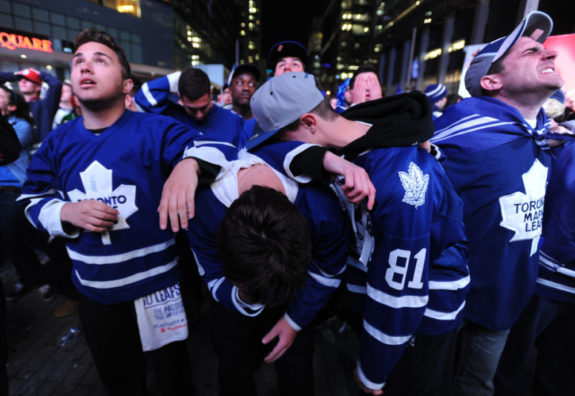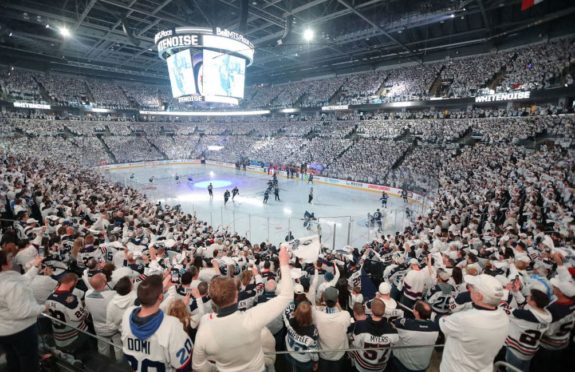By taking a look at the picture below, you can see the exact moment Toronto Maple Leafs fans experienced their infamous Game 7 overtime collapse to the Boston Bruins in 2013. If the sheer distraught and disbelief seen on the faces of these fans is indicative of anything, it’s that both players and fans can win and lose as a team…or at least it feels that way. But what is it that makes fans feel so attached to their favourite teams? And what is it that makes people so deeply infatuated with sports like hockey anyway? It’s just a game, isn’t it?

True to all forms of competition, sports like hockey must have a winner and a loser. Under these circumstances, narratives such as Us vs. Them and Good vs. Bad inherently arise — both part and parcel with the concept of tribalism. Ergo, we’re the good guys because we’re us, and they’re the bad guys because they’re them.
For thousands of years, these ideologies were paramount for the cohesion and survival of the tribe. While these same customs aren’t as crucial for survival in the 21st century, their remnants fuel both the passion and profit in today’s modern sports industry. In this article, I will be explaining what tribalism is and how its narratives have been interwoven within national, regional and individual levels of hockey to help sell the sport.
Tribalism: What is It?
Rooted deep within the human psyche, tribalism is an evolutionary survival tool defined as the state of being organized by, or advocating for, tribes or tribal lifestyles. In our not so distant past, declaring for a team or tribe improved the chances of survival significantly because it organized people into groups who they favored, trusted, and were able to depend on.
While it can be applicable to everything from politics to social media, tribalism is what’s responsible for a sports fan’s raw, unbridled emotional reaction to their favorite teams’ wins, losses and everything in between. Similar to sports fanbases, by identifying as a member of a particular team or tribe, you get your own unique colors, uniforms and history. You accept that your tribe is good and true, while others are bad and false.

Although humans are tribal in nature, how an individual is nurtured by another often dictates which group or tribe they identify with. With regards to national, regional and individual levels of hockey, sports marketers play on the many narratives related to different geographic and social rivalries in order to generate interest towards the game, promote fan identification, and at the end of the day, turn a profit.
National Lens: Canada vs. Russia
Of all the national hockey rivalries, there’s none more historically thrilling than that of Canada vs. Russia. Although it’s a somewhat one-sided affair for Team Canada, the two nations have consistently been in contention for international hockey supremacy and have passionate communities of fans to thank for it.
For anyone who isn’t a passionate Canadian, Russian, or fan of hockey, a matchup between the two countries may seem like a tough sell. But for someone who identifies as any one of those three things, it’s a battle between cultures, histories, heroes and villains.
Sports marketers know this, which is why advertisements for these matchups often emphasize a Canadian vs. Russian narrative meant to evoke patriotism and prompt purchases of things like themed hats, jerseys and other team-related gear. Not to mention the more eyeballs, the better it is for sponsors and the popularity of the sport itself.
Regional Lens: Maple Leafs vs. Canadiens
The rivalry between the Maple Leafs and Montreal Canadiens is one of the oldest and most bitter in all of professional sports. Dating back to the National Hockey League’s inception in 1917, cultural differences between the metropolitan cities of Toronto and Montreal have intensified their rivalry to epic proportions.
Beyond what happens on the ice, the historic hatred that exists between the two largest cities in Canada encompasses divisions between not just English and French Canadians but the provinces of Ontario and Quebec. Having met in the playoffs 15 times in Stanley Cup history, their rivalry has proceeded through generations as contests for the pride and glory of their teams, cities and provinces.
Whether you like blue and white, red and blue, speak French or English, or live in Quebec or Ontario, it’s undeniable that there’s always a little something extra involved when Montreal and Toronto are playing. And it gets more people wearing jerseys, watching games, and more money in the pockets of the NHL and its partners.
Individual Lens: Crosby vs. Ovechkin
Since entering the league in 2005, Sidney Crosby and Alex Ovechkin have been at odds with one another on countless occasions. Beyond competing for the rights to be the best in the world, Crosby and Ovechkin’s rivalry extends to the countries they’re from, the professional teams they play for, and their unique styles of play.
Born into rival hockey nations, Sid and Ovi have had the pleasure of meeting each other numerous times in international play for Canada and Russia. Additionally, the Pittsburgh Penguins and Washington Capitals — both division rivals — drafted each player and have had to go through one another to reach the Stanley Cup Finals. To boot, the two players also sport a different style of game, with Crosby known as a pass-first, all-rounded player, and Ovechkin being a prolific goal scorer.
The competing narratives that have surrounded the two players are microcosms for how sports like hockey generate excitement around their greatest teams and athletes. While Crosby and Ovechkin’s names will surely go down in history as individuals, it is the teams and ideas they represent that will have the largest impact and influence on the hockey community.
The Big Picture
At its core, hockey is just a game. But mixed with our tribal nature and desire to be a part of something bigger than ourselves, it’s become much more. While identity is a construct of our own choosing, there’s no doubt that where you’re from and your upbringing have a large part to play in the teams you cheer for and the players you associate yourself with.
Though tribalism can be cause for mindless hooliganism and violence, it has also shown the ability to be a tremendous mechanism for generating profit and passion from competition, allowing for sports like hockey to become a source of both pride and funding for communities all over the world.